The DC Universe (DCU) has been completely restructured and is now a brand-new continuity, entirely separate from the former DCEU — the cinematic universe launched by Zack Snyder. While there are some similarities between the two, the DCU represents a fresh start with its own storyline, heroes, and timeline.
According to James Gunn, who now oversees the DCU alongside Peter Safran, nothing was officially considered canon until the release of Creature Commandos. However, before the premiere of Peacemaker Season 2, Gunn clarified that “only what’s referenced counts as canon.”
As of now, three official projects have been released under the DCU banner:
-
Creature Commandos (2024) – Released
-
Superman (2025) – Released
-
Peacemaker Season 2 (2025) – Released
Several additional titles have already been announced for the coming years:
-
Supergirl (2026)
-
Lanterns (2026)
-
Clayface (2026)
-
Man of Tomorrow (2027)
-
Batman: The Brave and the Bold
-
Booster Gold
-
Paradise Lost
-
Swamp Thing
-
The Authority
-
Waller
All these productions — whether films, animated series, or live-action shows — are interconnected within the DCU, creating a shared narrative universe. However, it won’t be mandatory to watch every project to understand the main storylines.
Is Robert Pattinson’s Batman Part of the DCU?
No — the Batman movie starring Robert Pattinson exists in a completely separate universe known as “Elseworlds.” This label is reserved for DC projects that stand outside the main continuity. That means Pattinson’s Bruce Wayne has no connection to the new Superman or the DCU timeline.
Conclusion
The DCU under James Gunn marks a new era for DC fans, with a clear structure and a long-term storytelling plan. From Creature Commandos to Supergirl and Lanterns, the next few years promise to redefine the superhero landscape and bring cohesive storytelling back to DC’s big screen universe.

